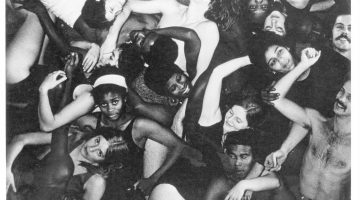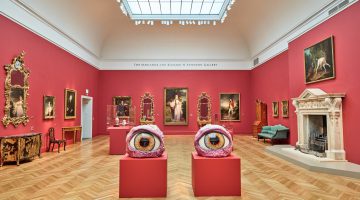By John Held, Jr.
Richard Diebenkorn was something of a painting prodigy, having his first major exhibition at the Legion of Honor, while attending The California School of Fine Arts (now the San Francisco Art Institute), when he was only 26 years old. By then, he had already seen the Sarah Stein collection of modern art as a Stanford student, and been to Washington, D. C., where he drank in the Phillips Collection, especially the work of Matisse.
By the time his Berkeley period (1953-1966) began, the focus of the present exhibition at the De Young Museum, he had already gone through an Albuquerque and an Urbana phase, and would go on to complete a much heralded Ocean Park series as well. Diebenkorn was always influenced by his immediate surroundings, which served as a springboard for much of his art, but he was also driven by the march of the paint medium itself, in an attempt to drive modernist history forward. It was not enough to recognize and absorb the importance of Picasso, Matisse, DeKooning, et al., but to incorporate and spit them out on his own canvas.
Is it just me, or do others like to get as close to a painting as possible, to step into the painters shoes, so to speak, and view the canvas in proximity to where the creative process was undertaken? Only then does the brushwork come to the fore. I have always judged a painter on his handling of paint, whether applied by brush or palette knife, or flung from some implement that the painter skillfully developed for the task at hand. Subject matter comes and goes, but the manner in which a painting is laid down remains a constant, altered only by the advancement of technique and inclination over the years.

Richard Diebenkorn
“Berkeley # 33, 1954” (Detail). Courtesy the Fine Arts Museums of San Francisco, the Richard Diebenkorn Foundation.
Having said all this, let me offer up some visual details from Diebenkorn’s works. The titles aren’t important, and the dates don’t matter. Just look at the way he moves paint around. That was his genius. His attention to detail and mastery of hand is best examined when divorced from external meaning and the focus illuminated by a singular facet of the work. It’s similar to a grain of sand representative of the entire beach. If you understand the essence of the thing, you get a better feeling for the whole of it.

Richard Diebenkorn
“Scissors and Lemon, II, 1959” (Detail). Courtesy the Fine Arts Museums of San Francisco, the Richard Diebenkorn Foundation.
The exhibition is extraordinary in its depth. It is a mammoth exhibition, including over 130 paintings and drawings. Diebenkorn has had a huge influence on succeeding Bay area painters, ranging in diversity from Wayne Thiebaud to Robert Bechtle. Never completely non-objective, Diebenkorn’s abstract works are always derived from some aspect of reality. Likewise, his more representational works always incorporate abstraction.

Richard Diebenkorn
“Interior with Flowers, 1961” (Detail). Courtesy the Fine Arts Museums of San Francisco, the Richard Diebenkorn Foundation.
This push-pull of abstraction and representation is what drives the show. Indeed, the work of this period, moving back and forth between the two, is what gives the exhibition such intensity. In all likelihood, this is the painting show of the year, and we are lucky to have the venue so close at hand. The only other stop the exhibition makes is the Palm Springs Art Museum, where co-curator Dr. Steven Nash is the director. It’s a tragedy of sorts that the show doesn’t go on to another major urban domestic setting or to Europe. Diebenkorn is an established Bay Area icon, and this show would have done much to extend his reputation to other geographical areas. Fortunately, an excellent catalog accompanies the show and ably serves the purpose of showcasing the range of his talents.
The Diebenkorn exhibition is enhanced by an accompanying exhibition of photography by Rose Mandel, “The Errand of the Eye.” The first comprehensive show of the photographer’s work organized by guest curator Susan Ehrens, Mandel was a student at the California School of Fine Arts in the 1940s, befriended and was admired by Minor White and Ansel Adams and went on to become a longtime photographer for UC Berkeley’s art department. Her portraits of Diebenkorn and Jay DeFeo are alone worth the visit, but other works in the show are revelatory and should not be missed.
My interview with co-curator Timothy Anglin Burgard, appearing in issue 13 of San Francisco Arts Quarterly can be accessed here: https://www.sfaq.us/pdfs/SFAQ_issue_thirteen.pdf
Richard Diebenkorn: “The Berkeley Years: 1953-1966”
June 22-September 29, 2013
De Young Museum, San Francisco, CA




